没有合适的资源?快使用搜索试试~ 我知道了~
首页A Practical Implementation Guide to Predictive Data Analytics Using Python
Mastering Machine Learning with Python in Six Steps A Practical Implementation Guide to Predictive Data Analytics Using Python
资源详情
资源评论
资源推荐

Cover
1

Cover
2

Manohar Swamynathan
Mastering Machine Learning with Python in Six Steps
A Practical Implementation Guide to Predictive Data
Analytics Using Python
Manohar Swamynathan
Bangalore, Karnataka, India
Any source code or other supplementary material referenced by the author in this book is
available to readers on GitHub via the book’s product page, located at
www.apress.com/978-1-4842-2865-4 . For more detailed information, please visit
http://www.apress.com/source-code .
ISBN 978-1-4842-2865-4
e-ISBN 978-1-4842-2866-1
DOI 10.1007/978-1-4842-2866-1
Library of Congress Control Number: 2017943522
© Manohar Swamynathan 2017
This work is subject to copyright. All rights are reserved by the Publisher, whether the
whole or part of the material is concerned, specifically the rights of translation, reprinting,
reuse of illustrations, recitation, broadcasting, reproduction on microfilms or in any other
physical way, and transmission or information storage and retrieval, electronic
adaptation, computer software, or by similar or dissimilar methodology now known or
hereafter developed.
Trademarked names, logos, and images may appear in this book. Rather than use a
trademark symbol with every occurrence of a trademarked name, logo, or image we use
Frontmatter
3

the names, logos, and images only in an editorial fashion and to the benefit of the
trademark owner, with no intention of infringement of the trademark. The use in this
publication of trade names, trademarks, service marks, and similar terms, even if they are
not identified as such, is not to be taken as an expression of opinion as to whether or not
they are subject to proprietary rights.
While the advice and information in this book are believed to be true and accurate at the
date of publication, neither the authors nor the editors nor the publisher can accept any
legal responsibility for any errors or omissions that may be made. The publisher makes no
warranty, express or implied, with respect to the material contained herein.
Printed on acid-free paper
Distributed to the book trade worldwide by Springer Science+Business Media New York,
233 Spring Street, 6th Floor, New York, NY 10013. Phone 1-800-SPRINGER, fax (201)
348-4505, e-mail orders-ny@springer-sbm.com, or visit www.springeronline.com. Apress
Media, LLC is a California LLC and the sole member (owner) is Springer Science +
Business Media Finance Inc (SSBM Finance Inc). SSBM Finance Inc is a Delaware
corporation.
Introduction
This book is your practical guide towards novice to master in machine learning with
Python in six steps. The six steps path has been designed based on the “Six degrees of
separation” theory that states that everyone and everything is a maximum of six steps
away. Note that the theory deals with the quality of connections, rather than their
existence. So a great effort has been taken to design eminent, yet simple six steps
covering fundamentals to advanced topics gradually that will help a beginner walk his
way from no or least knowledge of machine learning in Python to all the way to
becoming a master practitioner. This book is also helpful for current Machine Learning
practitioners to learn the advanced topics such as Hyperparameter tuning, various
ensemble techniques, Natural Language Processing (NLP), deep learning, and the basics
of reinforcement learning. See Figure 1 .
Frontmatter
4

Figure 1. Mastering Python Machine Learning: In Six Steps
Each topic has two parts: the first part will cover the theoretical concepts and the second
part will cover practical implementation with different Python packages. The traditional
approach of math to machine learning, that is, learning all the mathematics then
understanding how to implement it to solve problems needs a great deal of time/effort,
which has proven to be not efficient for working professionals looking to switch careers.
Hence the focus in this book has been more on simplification, such that the theory/math
behind algorithms have been covered only to the extent required to get you started.
I recommend you work with the book instead of reading it. Real learning goes on only
through active participation. Hence, all the code presented in the book is available in the
form of iPython notebooks to enable you to try out these examples yourselves and extend
them to your advantage or interest as required later.
Who This Book Is for
This book will serve as a great resource for learning machine learning concepts and
implementation techniques for the following:
Python developers or data engineers looking to expand their knowledge or career
into the machine learning area.
A current non-Python (R, SAS, SPSS, Matlab, or any other language) machine
learning practitioners looking to expand their implementation skills in Python.
Frontmatter
5
剩余268页未读,继续阅读
seo2002
- 粉丝: 2
- 资源: 11
上传资源 快速赚钱
 我的内容管理
收起
我的内容管理
收起
 我的资源
快来上传第一个资源
我的资源
快来上传第一个资源
 我的收益 登录查看自己的收益
我的收益 登录查看自己的收益 我的积分
登录查看自己的积分
我的积分
登录查看自己的积分
 我的C币
登录后查看C币余额
我的C币
登录后查看C币余额
 我的收藏
我的收藏  我的下载
我的下载  下载帮助
下载帮助

会员权益专享
最新资源
- c++校园超市商品信息管理系统课程设计说明书(含源代码) (2).pdf
- 建筑供配电系统相关课件.pptx
- 企业管理规章制度及管理模式.doc
- vb打开摄像头.doc
- 云计算-可信计算中认证协议改进方案.pdf
- [详细完整版]单片机编程4.ppt
- c语言常用算法.pdf
- c++经典程序代码大全.pdf
- 单片机数字时钟资料.doc
- 11项目管理前沿1.0.pptx
- 基于ssm的“魅力”繁峙宣传网站的设计与实现论文.doc
- 智慧交通综合解决方案.pptx
- 建筑防潮设计-PowerPointPresentati.pptx
- SPC统计过程控制程序.pptx
- SPC统计方法基础知识.pptx
- MW全能培训汽轮机调节保安系统PPT教学课件.pptx
资源上传下载、课程学习等过程中有任何疑问或建议,欢迎提出宝贵意见哦~我们会及时处理!
点击此处反馈



安全验证
文档复制为VIP权益,开通VIP直接复制
 信息提交成功
信息提交成功
评论0